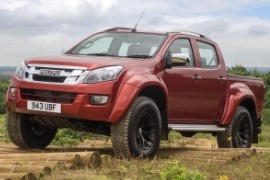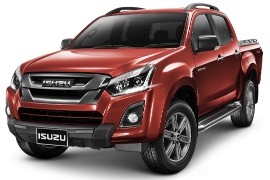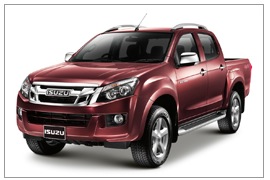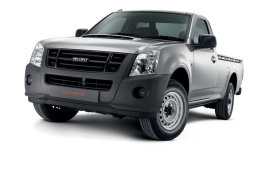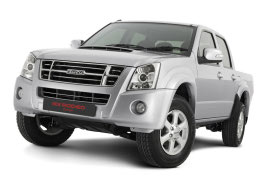ISUZU Rodeo / D-Max Models/Series Timeline, Specifications & Photos
First production year: 2002
Engines: Diesel, Gasoline
Body style: Truck
Engineered for the most difficult terrains in the world, the Isuzu D-Max (Rodeo) Arctic Truck AT35 was a technical showcase about the possibilities of the well-known Japanese pickup.
The D-Max was considered a true workhorse, with some comfort features for its occupants. The trustworthy 2.5-liter turbodiesel engine was one of the most fuel-efficient powerplants in its class and that was no wonder since Isuzu is the biggest diesel-engine manufacturer in the world. Arctic Trucks was an international company based in Iceland specialized in re-engineering four-wheel-drive vehicles for harsh terrain. It used to modify the Toyota HiLux for the Arctic expeditions and it teamed-up with Isuzu in developing the D-Max.
The general shape of the body was kept, but the overfenders and big bumpers were from the Icelandic specialists. The car was fitted with 35” tires on 10x17” alloy wheels. The car featured an onboard inflation kit, which allowed the inflation or deflation of the tires. To make room for the massive wheels, FOX suspension installed new coils and dampers for both axles. The D-Max Arctic Truck was available as a single or double-cab, but with the same wheelbase.
The chassis was reinforced with additional braces for more torsional rigidity. The front independent suspension and the rear axle helped the driver maintain full control of the vehicle on slopes or bumpy terrain. Under the hood, there was the same 2.5-liter turbodiesel as the standard D-Max. It was mated to either a 6-speed manual or to an optional 5-speed automatic with sequential control. Due to intensive modifications, the D-Max Arctic Truck AT35 didn't feature a hill descent control, but the engine braking combined with a low-range gear and big tires made that system irrelevant.
Isuzu refreshed the D-Max pickup in 2015, preparing it for the Euro 6b emission standards, and it slightly modified the exterior as well.
While most carmakers relied on the AdBlue (Diesel Exhaust Fluid) to lower the engine's emissions, Isuzu took the hard way. It relied only on the diesel particulate filter (DPF), and it changed the powerplant with a cleaner one but with a lower displacement.
From the outside, depending on the trim level, it featured a dark grille instead of a chromed one. The car still sported black, unpainted, wrapped-around bumpers both front and rear for the base trim level. The carmaker offered the double-cab in six specifications: Utility, Eiger, Yukon, Utah, Blade, and Arctic Trucks AT35. In the back, the 2015 D-Max featured restyled new taillights.
Inside, it was the same utility vehicle as before, with hard plastic on most areas. The carmaker built it with a specific user in mind: the one who would appreciate a rugged car more than an SUV-like one. There were two storage compartments in front of the passenger, one on top of the center stack and a fourth one in the center armrest. A new infotainment unit adorned the top of the center stack. Isuzu enlightened the dark interior colors with a few shiny trims on the center stack and the door panels. The carmaker offered good interior room for up to five passengers and, for the top trim level, it offered a choice for leather upholstery.
Under the hood, Isuzu installed a new Euro 6 compatible, 1.9-liter turbo-diesel engine. It provided 163 hp, and the carmaker paired it to a six-speed manual.
Isuzu introduced the second generation of the D-Max pickup in 2012, and while it shared its chassis with the Chevrolet Colorado, everything else was different.
The first generation of the D-Max spent ten years on the market and convinced the customers about its rugged, sturdy chassis and excellent fuel efficiency. It was refreshed once, but its wedged-shaped body showed the car's age. Then, the second generation came on the market with an important upgrade in all areas and one missing feature: the rear locking differential.
With its swept-back, angled headlights, the D-Max tried to look less rugged than before, even though it was. Its grille was slightly tilted backward, was black for the base trim levels, and chromed for the full-option version. Isuzu offered the D-Max in a few body versions, including a double-cab. All of them sported raked windshields and, depending on the trim level, roof rails, and side steps. The standard version sported steel wheels, with an option for light alloys.
Inside, the hard plastic on the dashboard was its main downside, but the design was elegant and useful. There were two storage compartments in front of the passenger, one on top of the center stack and a fourth one in the center armrest. Isuzu enlightened the dark interior colors with a few shiny trims on the center stack and on the door panels. The carmaker offered good interior room for up to five passengers and, for the top trim level, it offered a choice for leather upholstery.
Under the hood, Isuzu installed a choice of two engines: a 2.5-liter and a 3.0-liter, both turbo-diesel. It paired them with either a six-speed manual or a five-speed automatic. The 4x4 system employed a transfer case with high and low gears.
In the same time when Isuzu was selling the rebadged 5-door Opel Frontera in the U.S. as the Isuzu Rodeo, the same name was used to sell the D-Max pick-up truck. The vehicle was a joint effort together with GM. Basically, the frame was also used by GM for the Chevrolet Colorado pickup truck, but Isuzu took a different approach for its pickup body. Manufacturing was in Thailand and, later on, in Turkey, at their joint-factory in Bursa with AIOS Turkish company.
Even if there was only one engine under the hood, a 2.5-liter turbodiesel, there were different bodyworks available, one of them being a single cab with a longer loading bed. It had two doors and, unlike the crew-cab, had two seats. The single-cab was available only as an RWD model, while the others could be ordered with a 4x4 transmission. The single-cab version was intended as a true working horse, with limited comfort but able to carry over 1-ton payloads. While the four-door versions received a 3.0 turbodiesel, the base 4x2 single-cab version held to the 2.5-liter unit. It was updated, though, according to the newest anti-pollution regulation norms in the EU.
The single-cab was available either as a chassis-cab, to receive specific bodies, or with a bed for loading different materials and a rear tailgate. Its production ended in 2011 when a new generation of the D-Max was launched. The Rodeo name was used for Isuzu Pickup only on some specific markets.
Isuzu brought a new pickup on the market, and it made it available for the European continent as well. It was available with three cabin options, with the Crew-cab as the top version.
At the same time, when Isuzu was selling the rebadged 5-door Opel Frontera in the U.S. as the Isuzu Rodeo, the same name was used to sell the D-Max pick. The vehicle was a joint effort together with GM. Basically, the frame was also used by GM for the Chevrolet Colorado pickup, but Isuzu took a different approach for other countries' versions. Manufacturing was in Thailand and, later on, in Turkey, at their joint-factory in Bursa with AIOS Turkish company.
Unlike other crew-cab pickups, Isuzu named this way its four-door version. It offered the same dashboard design with a tall center stack where it installed, depending on the trim-level, an aftermarket CD-player. The rugged buttons and the industrial design were fit for the hard-working vehicle, which was able to cope with hard offroad situations.
Even if there was only one engine under the hood, a 2.5-liter turbodiesel, there were different bodyworks available, one of them being a single cab with a longer loading bed. It had two doors and, unlike the crew-cab, had two seats. The crew-cab was intended as a workhorse, with limited comfort for the rear passengers, but able to carry over 1-ton payloads. Isuzu updated it constantly to fit into the European emission regulations. The Japanese carmaker used the Rodeo name for D-Max only on specific markets.
